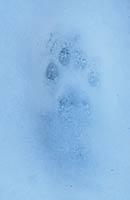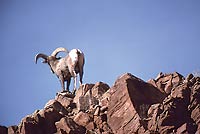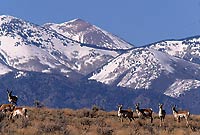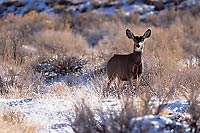 January is the heart of winter in Canyon Country. Snow and ice often blanket the landscape bringing a hushed reverence. The month’s average daily temperatures are 43 degrees for the high and 20 degrees for the low. Single digit lows are not uncommon and when the wind howls, you’d not want to be outside with only your spurs on.
January is the heart of winter in Canyon Country. Snow and ice often blanket the landscape bringing a hushed reverence. The month’s average daily temperatures are 43 degrees for the high and 20 degrees for the low. Single digit lows are not uncommon and when the wind howls, you’d not want to be outside with only your spurs on.
However, it is also a magical time of year. Many wildlife species are still active, except for the reptiles that snooze away winter deep within protective burrows, and the ever-present raven that seems to appear out of nowhere. Beneath the snow’s surface exists an environment insulated against the cold where small rodents and mammals burrow and forage on seeds or plants. This “subnivean” world also provides food for predators such as foxes, coyotes, and owls whose acute hearing can detect small creatures moving beneath the snow’s surface. Sometimes the wispy imprint of an owl’s outstretched wings on the snow betrays their presence.
 Of course, these and other predators such as bobcats and cougars will take larger prey that travel above the snowpack such as rabbits, jackrabbits, squirrels, and, in the case of cougars, mule deer. Birds are also present, foraging on seeds, berries, nuts, overwintering insects, and tree buds depending upon their diets. Jays who spent the fall caching pinyon nuts dig up their supplies to sustain them through the winter. Travelers in the mountains may encounter Canada jays or Clark’s nutcrackers, hardy birds that spend their winters in the upper elevations.
Of course, these and other predators such as bobcats and cougars will take larger prey that travel above the snowpack such as rabbits, jackrabbits, squirrels, and, in the case of cougars, mule deer. Birds are also present, foraging on seeds, berries, nuts, overwintering insects, and tree buds depending upon their diets. Jays who spent the fall caching pinyon nuts dig up their supplies to sustain them through the winter. Travelers in the mountains may encounter Canada jays or Clark’s nutcrackers, hardy birds that spend their winters in the upper elevations.
Like summer, species of wildlife are active at night so winter wildlife may be challenging to locate. Often their tracks or piles of scat are the only indicators that they’ve passed through the area. Some may switch their activity patterns to the daytime, a testament to this cold time of year.
When I lived in Moab and wanted to seek out winter wildlife, here are several areas that I would visit.
The Nature Conservancy’s Scott M. Matheson Wetlands Preserve on the north end of town offers some great habitat for wildlife on the outskirts of town. Passerines and waterfowl, if the open water areas are not frozen, are good bets along with birds of prey such as Cooper’s and sharp-shinned hawks, bald eagles, and red-tailed hawks. Mule deer and rodent populations may be evident by their tracks.
 The Cisco Desert. Driving along the Colorado River’s Highway 128, AKA the River Road, may be exciting enough where waterfowl seem immune to the cold river and where an occasional glimpse of a river otter cements my respect for them hunting fish in the chilly Colorado. Where the road crosses the Colorado, the landscape opens up. Here, herds of pronghorn patrol the plains, rough-legged hawks hunt small mammals, and coyotes and golden and bald eagles squabble over roadkill.
The Cisco Desert. Driving along the Colorado River’s Highway 128, AKA the River Road, may be exciting enough where waterfowl seem immune to the cold river and where an occasional glimpse of a river otter cements my respect for them hunting fish in the chilly Colorado. Where the road crosses the Colorado, the landscape opens up. Here, herds of pronghorn patrol the plains, rough-legged hawks hunt small mammals, and coyotes and golden and bald eagles squabble over roadkill.
Anticline Overlook. Another good area for pronghorn, mule deer, small mammals, and birds. Patches of pinyon and juniper provide cover, and rocky recesses offer denning sites. The wind-swept plateau is often quiet, devoid of the summer traffic heading out to the overlooks.
Viewing winter wildlife is a treat and a pleasure. Please remember to enjoy these creatures from a distance; harsh winter conditions are enough of a stressor on their survival.